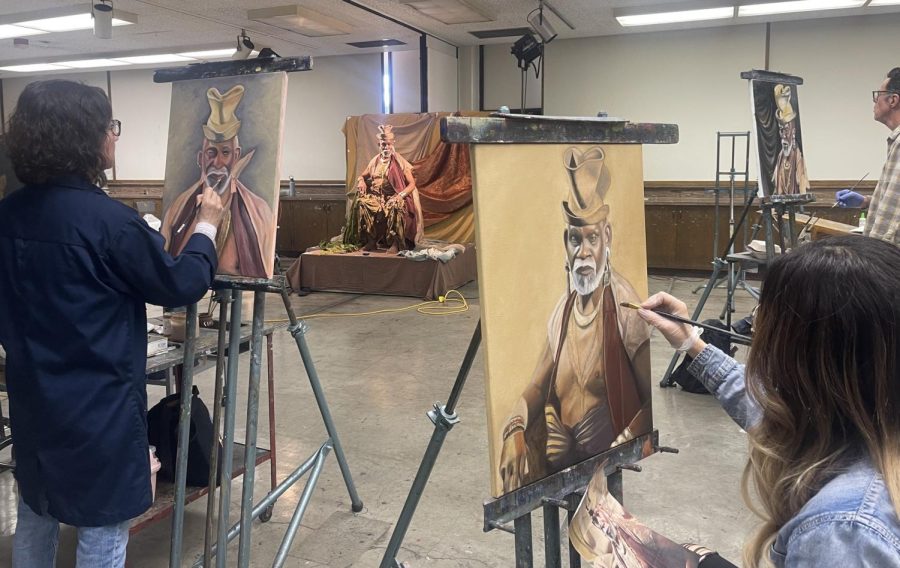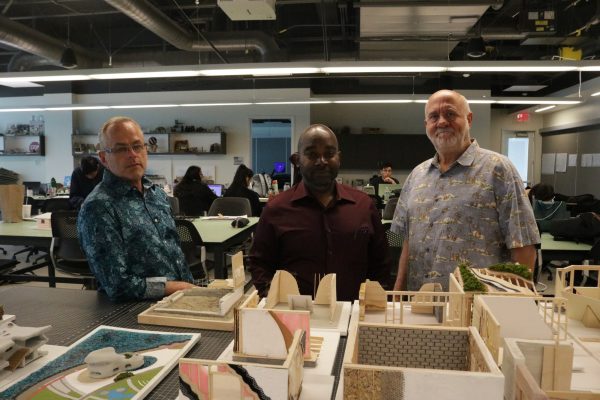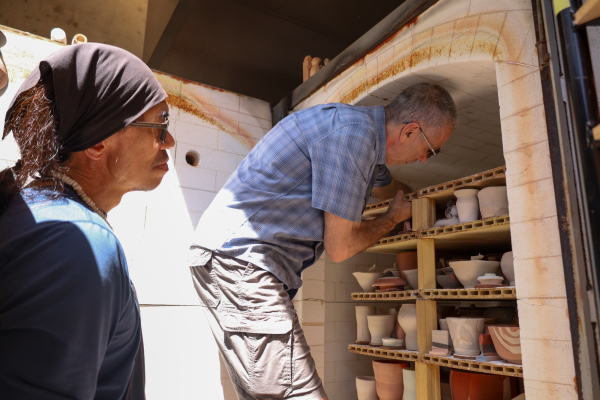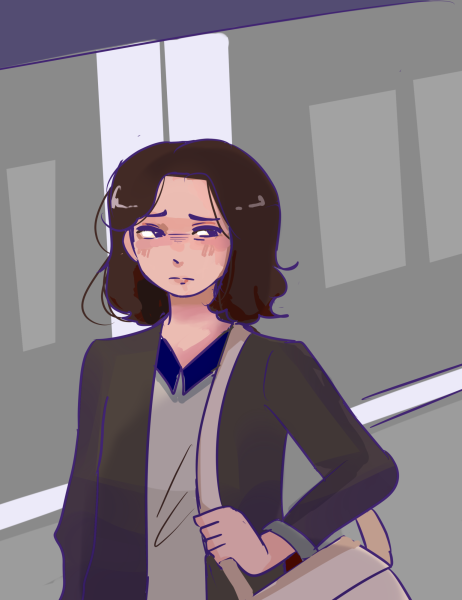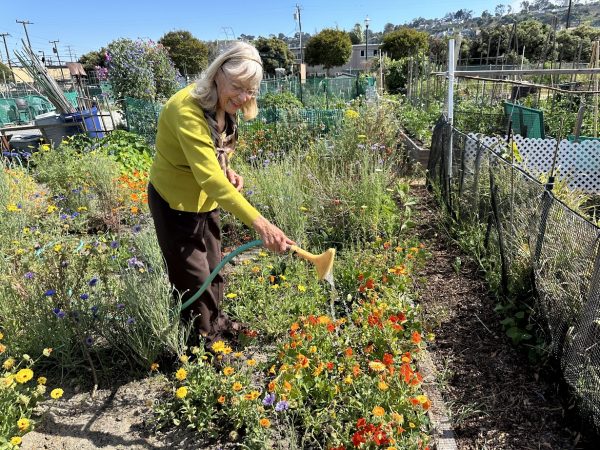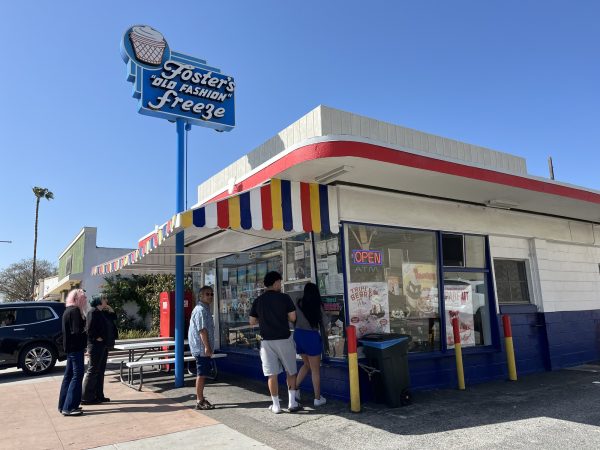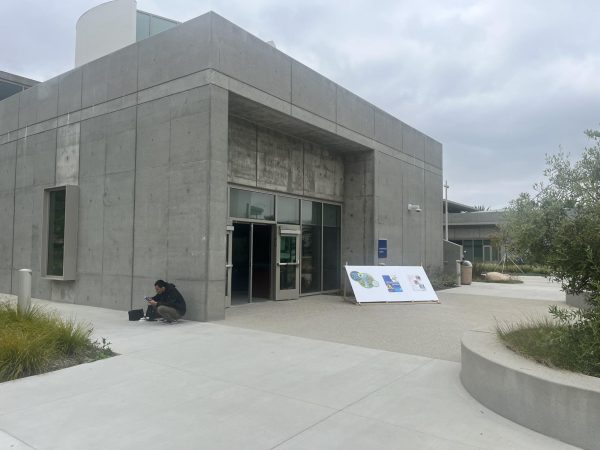The naked truth: Art models at El Camino inspire students to portray humanity in all its forms
J.J. Cole (center) models in a life drawing class at El Camino College on April 4, as students Hyekyung Kim (left) and Fumie Coello (lower right) paint his portrait. Cole has worked as an art model for 25 years after retiring from a career as a professional dancer in Houston, New York City and Los Angeles. (Kim McGill | Warrior Life)
*This article contains nude photo and illustrations.
Jonathan Beck slides quietly into the large, concrete classroom that smells of paint and dust and maneuvers his way through a jungle of heavy iron drafting easels and metal chairs. Dodging discarded charcoal and pencil lead scattered across the floor and avoiding eye contact with the strangers gathered there, he steps carefully onto a worn wooden platform.
His bearded chin tilts up and long gray hair falls from all parts of his head except for a perfectly round, bald top.
With dark eyes hidden under bushy eyebrows, he looks out for the first time, squinting under the bright production lights that are aimed at him. The lines that cross his face suddenly shift and he grins.
Then he drops his robe.
Imagine Gandalf the Grey, naked.
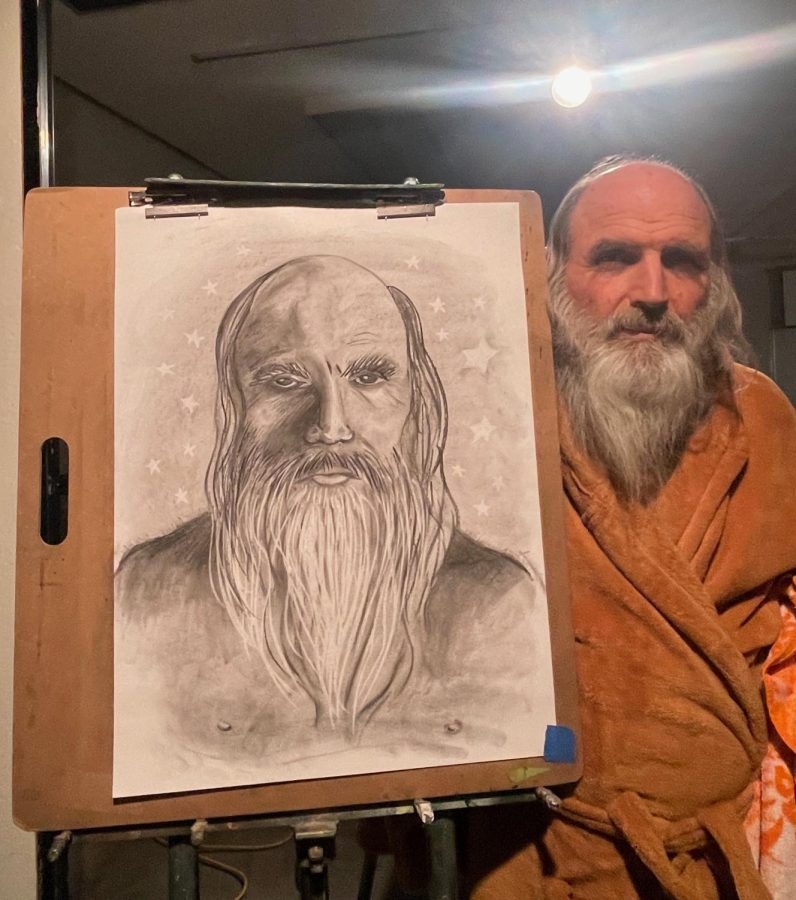
The purest form of humanity
Art models at El Camino College – and at schools and studios throughout the world – pose naked before hundreds of people each week who they might never see again.
They work alone in the midst of crowds.
They exist in a fishbowl, capturing the attention of everyone, two to 20 minutes at a time.
“Nudity is universally relatable,” says art model Andrew Cahner, 55, of Santa Monica. “It’s the purest form of humanity. When you eliminate clothing or the uniform, it makes it more timeless. You can look at Renaissance art and they look pretty much the same as we do.”
For students, a life drawing class is often the first time they have ever fully seen a naked body. The initial reaction elicits some small gasps, even a suppressed giggle. But within seconds, students adapt despite their shyness and get to work capturing on paper what they see.
“It takes a lot of courage to be vulnerable the way they are,” El Camino dance major Mia Vargas, 19, says of the models.
“One of the great things about teaching life drawing or life painting is that it puts the nude body into a special context very different from how most of us and our culture responds to nudity,” says Randall Bloomberg, El Camino art professor since 2001. “It’s great to look at a naked person and respond to it in an artistic way that is elevated from sexuality.”
Known as a “gesture model,” Cahner has established a reputation for creating dynamic, complex and physical action poses. He does a lot of work for animation studios and animation classes.
“Nudity is not sexual unless it’s made to be,” Cahner says.
During one class at El Camino, he wears a tall chef’s hat and pretends to chase a yellow rubber duck with a plastic cleaver, while students race to capture the skeletal structure within each pose.

These poses are far from erogenous.
The civilizations of the ancient Maya, Egyptians and Greeks were not uncomfortable with, or condemning of, public nudity. The Renaissance promoted study of the human body as an important component in the advancement of art, science and philosophy.
But, as both the Catholic and Protestant Church gained political and cultural power throughout Europe and spread their influence worldwide through colonization and the transatlantic slave trade, strict morality codes were adopted that denounced revealing even small sections of the human body.
Laws were especially harsh in the shaming and control of women and LGBT2IQ2 people.
This history has had a significant impact on American culture, where Puritans played a huge role in the nation’s development.
Most Americans remain uncomfortable looking at – or allowing others to look at – the human body, and have institutionalized, incarcerated and even put to death people who challenge that core value.
The current culture wars dominating U.S. politics are again eliminating instruction on Michelangelo’s David from classrooms and banning books that discuss anything from menstruation to reproduction.
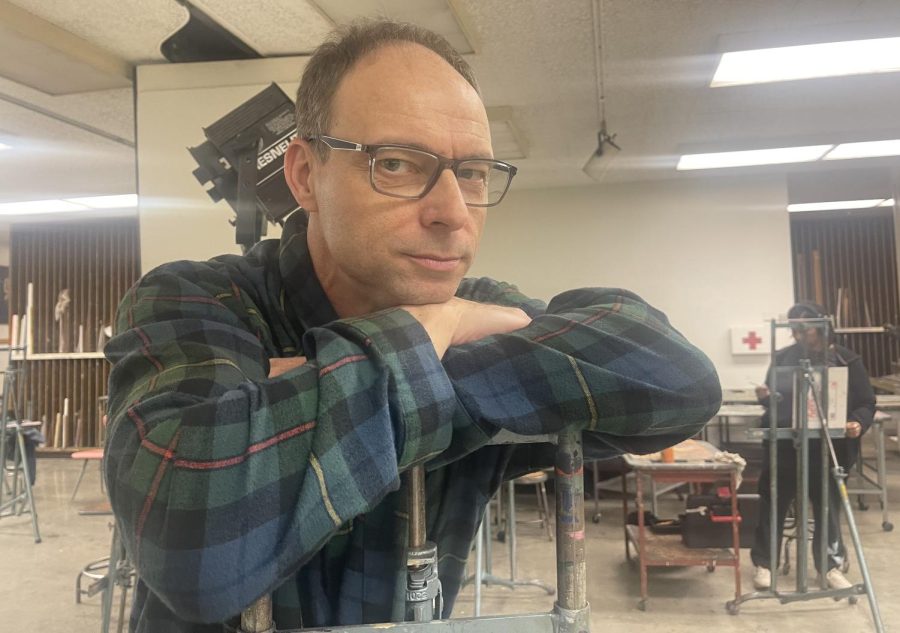
Jonathan Beck knows that many people assume that naked modeling is somehow immoral or sexual. He finds this ridiculous. His wife was once challenged about her modeling, and she asked, “Is it sexual to take a shower or to go to a nude beach?”
After serving as a Navy pilot, Jonathan Beck traveled to Canada and lived on a commune. An older man he met there confronted a Royal Canadian Mounted Police officer who threatened to arrest people for public nudity.
Jonathan Beck recounts this story:
“The officer told him, ‘You should be ashamed.’ The man responded, ‘You were there when they crucified Christ. What you wear on your hip brings death and destruction. What I expose brings pleasure and life onto this earth.”
Jonathan Beck says that people have a “contorted” view.
“Breasts are for sustenance. Vaginas are how we all got here,” he says. “The human body is one of the most beautiful things on the planet. It should be drawn.”
Jonathan Beck once showed up at a class to model and all the “old guys” in the class got up and left.
Maybe they were expecting a female model, he says.
“You shouldn’t be drawing to get aroused,” Jonathan Beck says. “They were there for the wrong reason.”
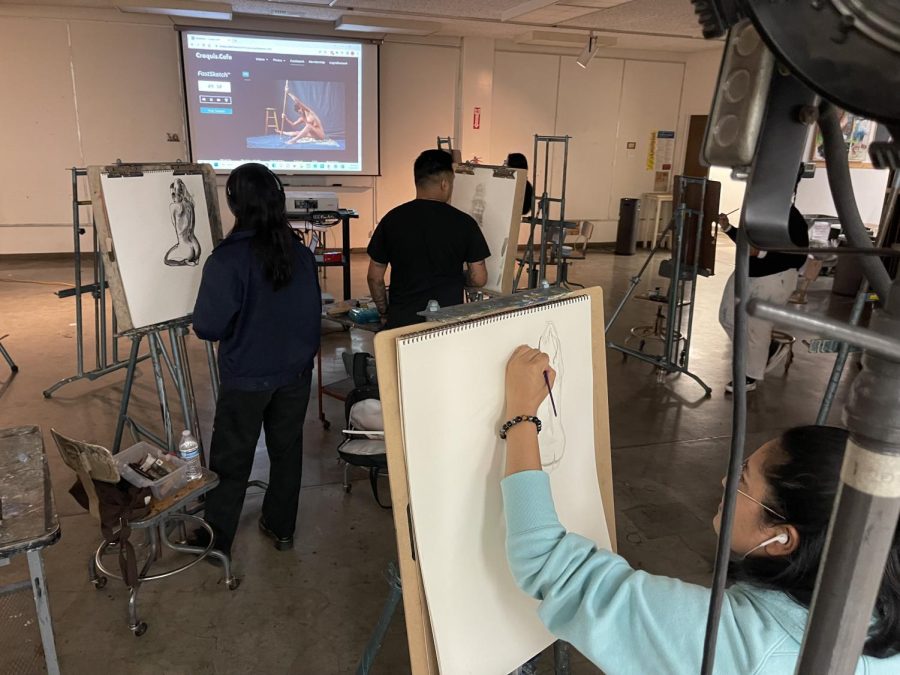
Famous, not famous
J.J. Cole has transformed the wooden model platform in Art 205 on the second floor of ECC’s Art and Behavioral Sciences building into a throne adorned with gold and brown fabrics. He wears a tall woven hat, robes are draped over his shoulders, and he decorates his neck, ears and wrists with jewelry.
He has studied the images of African kingdoms and also draws inspiration from his family.
“I know many people who are very royal, very upright,” Cole says.
At 68, he is the fifth generation of his family in the U.S. from Nigeria. His grandparents were enslaved. His parents worked as sharecroppers in Winfield, Louisiana then migrated to Texas. He was born and raised in Houston, went to college in Pittsburgh and performed in dance and theater in New York City until, at 43, he retired from dancing and began modeling. He now lives in Pasadena.
“My parents always instilled in us that you must show your light, never hide it. You must be regal. So, I am in that mode,” Cole says. “I present that, because that’s what I am.”
He says the extra attention he puts into setting up his poses also comes from working with theater designers and stage directors who transported audiences to magical places.
“My role is to promote unification, universality, interconnectivity,” Cole says.
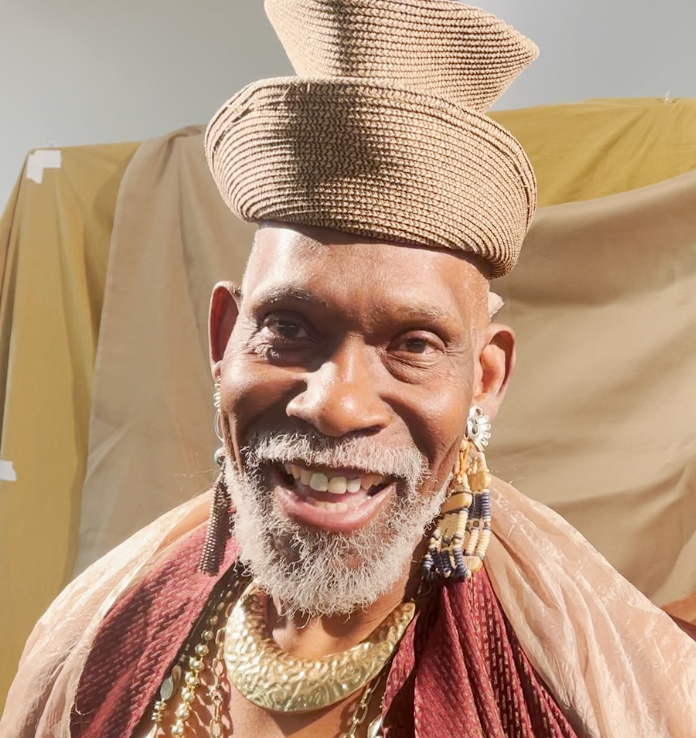
While Cole rules lovingly over his art class kingdom, he walks through campus without being recognized.
El Camino’s life drawing models are simultaneously some of the college’s most famous and least-known staff.
Their contact information doesn’t appear anywhere in ECC’s directory, but their likenesses decorate the art program’s hallways, fill student portfolios and adorn the walls at campus exhibitions.
They travel hundreds of miles a week to art schools throughout Southern California, yet hardly anyone knows their names.
Their life experiences, skills and academic degrees are endless, yet they are rarely celebrated.
Before the Renaissance, images – whether on canvas, in sculpture, pottery or tombs, or decorating the walls of the world’s great pyramids and cathedrals – included depictions of humans, animals and gods, but were not focused on realism.
The Renaissance, from the 14th to the 17th centuries, pushed the use of life models with an emphasis on capturing the exact anatomy, expressions, perspectives and proportions of the human form and its environment.
Art models have been a central component of art instruction and creation ever since.
In life drawing classes, it is often required that students study drawings and paintings by “master artists” that are considered essential to understanding both the craft and traditions of art.
The art models are almost never identified unless they were part of the ruling class.
Masterpieces have titles such as “Bearded Old Man with a Wart,” by Wenceslaus Hollar (1607-1677), “Head of an African” by Albrecht Dürer in (1471-1528), “Reclining Male Nude with His Left Arm Shielding His Eyes” by John James “J.J.” Masquerier (1778-1855), or “Naked Sailor” by William-Adolphe Bouguereau (1825-1905).
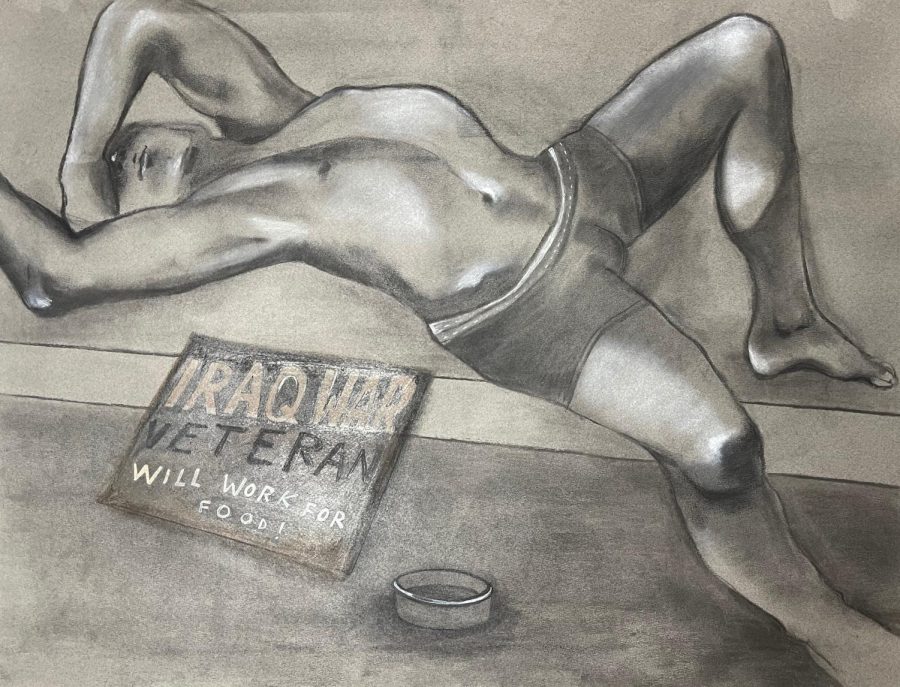
Models who gave so much of themselves to the creation of great art were made invisible.
Their smile, a glance, every sinew of muscle, every crease on their face and the most intimate parts of their bodies have been examined, studied, stolen, copied, sold, celebrated and counterfeited worldwide for centuries, but their names and their stories are unknown.
In more than 500 years, little has changed.
At El Camino, the work of life models enables students to access awards, scholarships, acceptance into university art programs, and employment in competitive art and animation fields.
But models are rarely credited or thanked.
When artwork is sold in galleries, to museums or at auction, the models and/or their descendants don’t share the profits.
Leonardo da Vinci’s Mona Lisa is valued at more than 50,000 million euros, but neither the painting or any income it generated was ever shared with its model Lisa Gherardini or her descendents. She was the wife of a wealthy Italian silk merchant who originally commissioned the painting. The vast majority of models – then and now – are working class and low-income people.
Jonathan Beck introduced his brother Tim Beck, 74, to modeling 20 years ago.
Tim Beck agrees that art models have been largely forgotten throughout history. But he also imagines that models enjoyed some public recognition while they were alive.
“Before the printing press, before photography, before there were movies, there was the artist. Art models would have been the movie stars of 500 years ago,” Tim Beck says.
Cahner doesn’t focus on the lack of recognition.
“It’s not about me,” he says. “I’m there for the students and the client.”
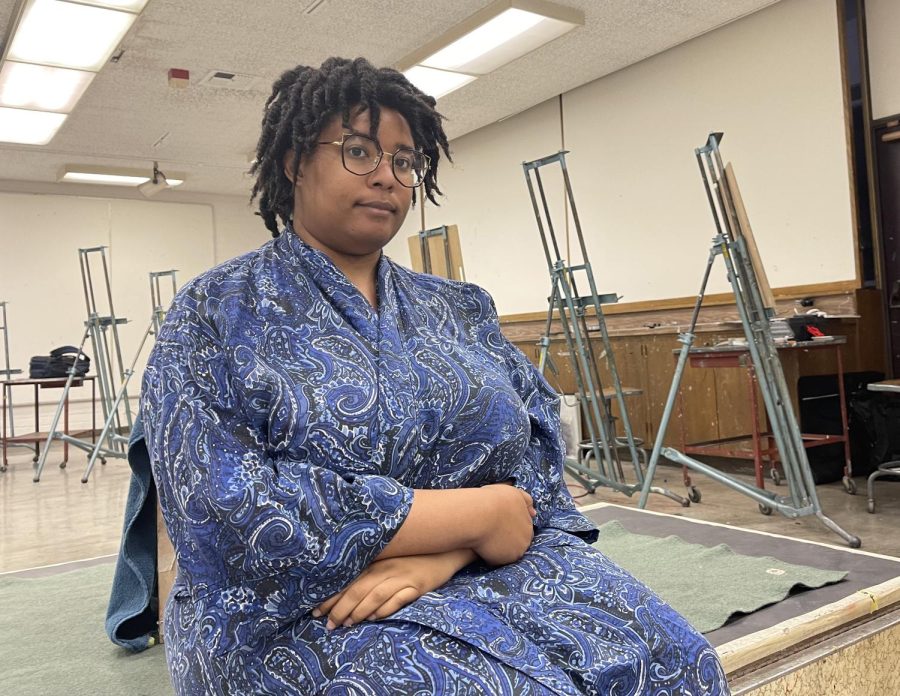
As for Jonathan Beck, even in Hollywood, he has remained mostly anonymous.
He’s been a TV and movie extra including working as a zombie on “The Walking Dead” and a humanoid robot on HBO’s “Westworld.”
His most famous live modeling moment was on “The Late Late Show.” Host James Corden, Jordana Brewster, Dave Grohl from The Foo Fighters and Rainn Wilson all drew him. The segment has more than 1 million views on YouTube. After the episode aired, the show’s producers contacted him about delivering pizzas naked and he agreed. But Jonathan Beck says the network lawyers were worried about liability and the segment was crushed.
“Art models should get more respect,” Jonathan Beck says.
He is concerned when he’s modeling and students are on their phones. Models face possible exploitation if pictures are taken without their permission.
“You don’t know where your image will be used,” Beck says.
He says it’s also rude to be talking on your phone or texting when models are working.
“Models should be introduced. We’re not expecting it, but instructors should still say ‘Let’s give the model a big round of applause.’ I appreciate it when I get a thank you,” Jonathan Beck says. “We’re not objects, we’re people.”
Bloomberg says that when he was in art school in New York, there was no conversation between models, professors and students.
“These are people that are helping us in our classroom activities, but I didn’t feel comfortable talking to the models, because the teachers didn’t introduce them,” he says.
On a class break, Bloomberg and other students were sitting in the hallway, and the model came out and sat near them.
“No one talked to him,” Bloomberg says. “I could tell he was really uncomfortable. I remember thinking that was so wrong. I believe it was the instructor that did not set the situation up right.”
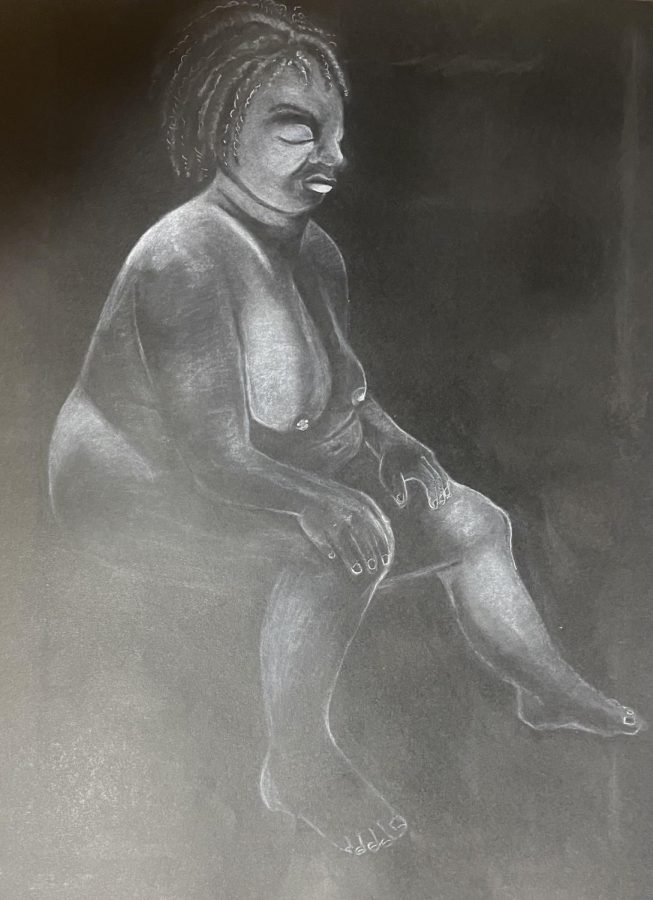
Cole has been modeling for 25 years. He is disciplined and conscientious. He never breaks focus. He completes each 20-minute session warning students to watch as he holds the pose for “three, two, one and done.”
He ends the class cheering for the students and their work.
“Bingo! You did it. Great job everyone!” Cole says.
And he claps for everybody present.
“We are human beings, and if we do not celebrate that, then we withdraw, we get caught up in the matrix of existence. At the end of a class when everyone is working, grasping, learning, achieving, understanding that energy that we have, I know I didn’t do it alone,” Cole says. “So, let us cheer our work, let us appreciate this moment because we’ll never get it again.”
An incredible design
On a warm Saturday morning, Tim Beck saunters across the parking lot of a strip mall in Torrance, wearing a wide brimmed black-felt hat. He enters his favorite neighborhood doughnut shop – smashed in between a nail salon and a liquor store – orders a muffin and large coffee, and without hesitation begins to talk about art modeling with a childlike enthusiasm.
“I think there’s a little jealousy, even with the art teachers. Everybody pays so much attention to us. We’re the center of attention for three hours,” Tim Beck says.
Bloomberg explains that making a drawing of a human body is complex, requiring the development of observational drawing skills, perceiving the model and translating the human figure onto paper or canvas, understanding the shadows, the values – lights and darks, and breaking the human body down into geometric shapes, all in order to make the drawing convincing.
You can learn by copying master works by other artists as well as drawing from photographs, says Bloomberg, and both of those techniques are regularly used in art classes.
But he says those techniques are limited.
“The human body is this incredible design,” Bloomberg says. “There’s proportion and harmony that you can only understand by working directly with live models.”
He argues further that having students in the classroom with a live model is “incredibly inspiring” and important to an artist’s development.
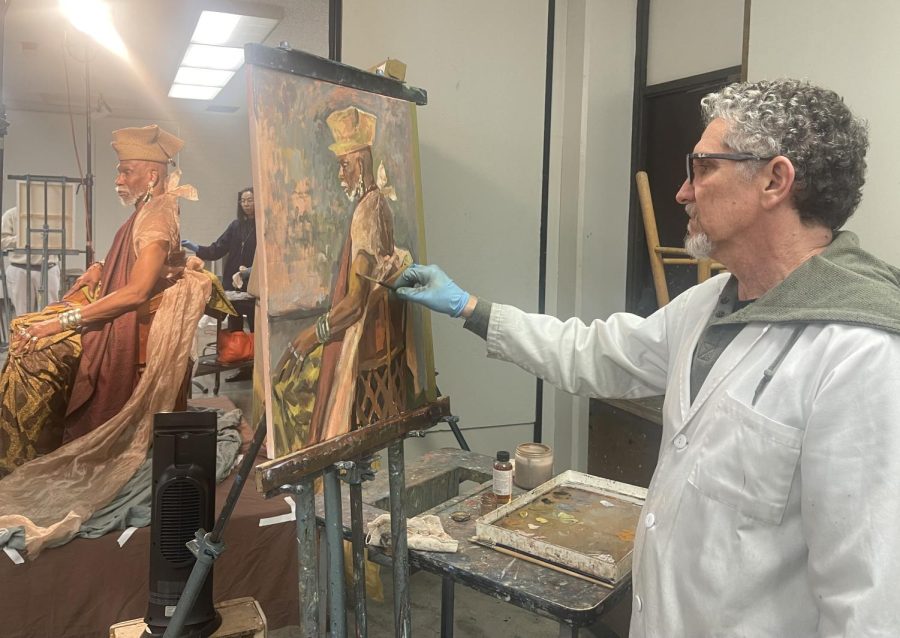
“Live models are essential because they show many different angles of the body, shapes, colors, light and shadows,” El Camino art student Fumie Coello says. “Photographs are more limited in showing those details.”
Cahner explains that a photograph is two-dimensional. The camera will distort the image. He says the whole point of drawing from a model is to transfer all the complexities of a three-dimensional subject onto a flat page.
“I don’t have any aptitude for art,” Cahner says. “I love being a fly on the wall in all these art lectures. The magic of how it all happens is fascinating when someone is successful at a drawing or painting.”
During the Renaissance, artists drew from corpses but quickly realized the need to observe humans with different facial expressions, in various positions and interacting with other people, animals and the world around them.
El Camino art student Zamira Recinos says that looking at a drawing or photograph only gives her one perspective.
“Working from an art model helps me to understand the full form of a person since I get to thoroughly examine what I’m looking at (including moving to see all sides),” Recinos says.
Without art models providing people a 360-degree opportunity to study and draw the human anatomy, Bloomberg says, visual arts and design would be severely limited.
“It’s like practicing your scales in a music class. If you can learn to draw the human figure, you can draw anything,” says Bloomberg. “You want to have that foundation to have any career in the visual arts. It gives you enormous sensitivity to composition and proportion for painting and sculpture, but also for animation, architecture and jewelry design.”

Hard and strenuous work
Lily Caraballo, 32, grew up in Queens and went to Lehman College in the Bronx. She earned her Master of Fine Arts in creative writing from Antioch University in Los Angeles. Modeling gives her some income to support her work writing non-fiction and critical essays.
She highlights how important modeling is to artists and speaks about the relationship as mutually beneficial.
“The students are working to perfect their craft. We are here to support that,” Caraballo says. “What do models want? Mutual respect,” she says, and for people to understand how physically challenging the work is.”
An art model’s job is strenuous. They maintain difficult poses, without moving. They often work long hours without food, water or clothing, seeking warmth from small space heaters in the cold, and a break from the heat on blistering days with an electric fan.
Tim Beck jokes that he performs the more difficult, standing poses, in “the stance of a warrior” while his brother, Jonathan Beck, “likes to lie down.”
The pose Tim Beck is describing is contrapposto, meaning “opposite” in Italian. Originated by the ancient Greeks, it requires the model to rest all their weight on one leg, and the pose can cause significant pain.
“When I’m modeling, if I don’t want to take a pose that’s too difficult or will injure my body, I won’t do it,” Jonathan Beck says, adding that models must protect themselves on the job
He used to model for a professor at a local university that he says had a terrible relationship with models.
“He is so dictatorial. Once, he wanted me to twist my neck looking backwards for six hours. I’m not gonna do that,” Jonathan Beck says. “He [the professor] said ‘You’re the model,’ as if I had to do whatever he said. It was that whole domination thing where he saw me as his little servant.”
Jonathan Beck believes the minimum that all models should expect is a clean model stand that is close enough to the floor that it’s not difficult or painful to step down from after a pose, a temperature that is neither too hot nor too cold and heaters and fans available to adjust the climate as needed, a pole to lean on – essential for many poses that require a lifted arm or the concentration of weight on one leg and smaller five-minute breaks every 20 minutes as well as a 20-minute break every two – three hours.
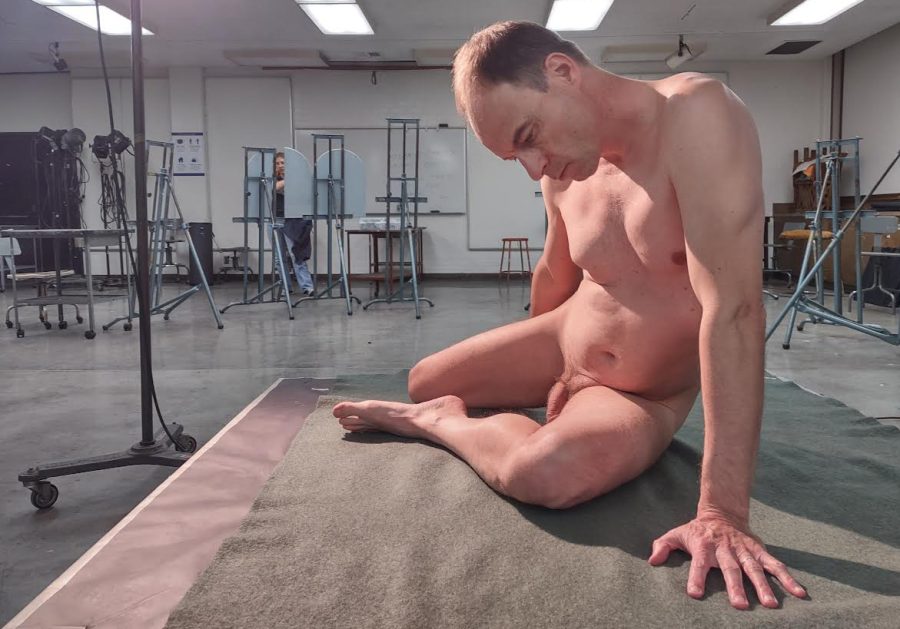
The Uber or Lyft of the art world
Niccole Blair travels nearly 88 miles, often more than a four-hour round trip drive, all the way from Crestline, Calif., near Arrowhead, to El Camino College. Some places she models for are even farther away.
On Dec. 13, 2022 she left before dawn during the season’s first snowfall. Her boyfriend helped her clear the snow from her car. She just got a new four-wheel drive.
“That will help,” she says.
When the historic winter storms hit Southern California in February, Blair was snowed in for nearly two weeks. There was a strong mutual aid network that neighbors set up for each other – especially needed when the roof of the local market caved in under the weight of the snow – but the world outside the mountain communities supported only briefly and barely, she says.
She lost nearly two weeks of work. There is no emergency pay or disaster relief available for her or other models.
Life models hustle year-round for opportunities. They are among the world’s oldest gig workers.
“We are like Uber or Lyft of the art world,” Jonathan Beck says.
Cole has 475 clients – universities, colleges, studios, art classes – and he works “morning, noon and night,” finding time to rest in between.
At El Camino, models earn $30 an hour and get free parking. But, hourly rates can be less, and some schools make models pay for parking.
Art models receive no health insurance, retirement, paid vacation, holidays or sick days at ECC or any of the other schools and studios they work for. The profession is not unionized.
They travel hundreds of miles a week to different colleges, art schools and studios, but none of the models at El Camino are reimbursed for public transportation, mileage or gas.

Marguerite Garner lives in Torrance and has been modeling at El Camino for 20 years. In addition to El Camino, she drives to work at the Laguna College of Art and Design in Laguna Beach and Saddleback Community College in Mission Viejo.
In addition to parking, Garner explains that some schools make models pay for fingerprinting and blood or urine testing. Since COVID-19, models are also required to get regularly tested, get all their vaccines and remain masked at all times.
“If you’re going to be taking your clothes off in front of minors, they want to be careful, and I understand that,” Garner says.
But, she adds, it’s expensive, especially when models have to repeat the tests for multiple sites.
“Professors champion us, but college administrations might not understand our importance. Some models have quit and won’t come back,” Garner says.
Cahner started modeling 20 years ago and it’s been his main job for 15 years. He generally works for 20 to 25 schools and art studios each semester.
“You take what you’re offered. You either say yes, or they’ll find somebody else,” he adds.
There are days when he wakes up at 5 a.m. to work an early morning class then covers a night class at 8 p.m.
“There is no typical day,” Cahner says.
Garner says that models have rarely been well compensated, if at all.
In the past, some were wealthy or famous beauties, explains Garner. But, many more were “mistresses, courtesans, and wives.”
“Picasso had a few,” she says.
Toulouse-Lautrec painted exotic dancers and sex workers.
People who were enslaved or unhoused or laborers in the homes where artists lived were often depicted. Power imbalances make it questionable whether many models could say no.
“It [art modeling] was traditionally the wheelhouse of street people,” Garner says.
Cahner says that there is a lot of unpaid time for travel, scheduling and growing administrative requirements.
“One universal thing in higher education is expanding bureaucracy and that’s getting more egregious over time,” he says.
During COVID when schools shut down, some colleges and art studios ignored commitments and refused to pay models anything. Many models struggled to survive financially.
“I come from a business background, and it’s been very revealing to me how – from a management perspective – organizations treat their least powerful constituents,” Cahner says. “Times of crisis don’t build character, they reveal character.”
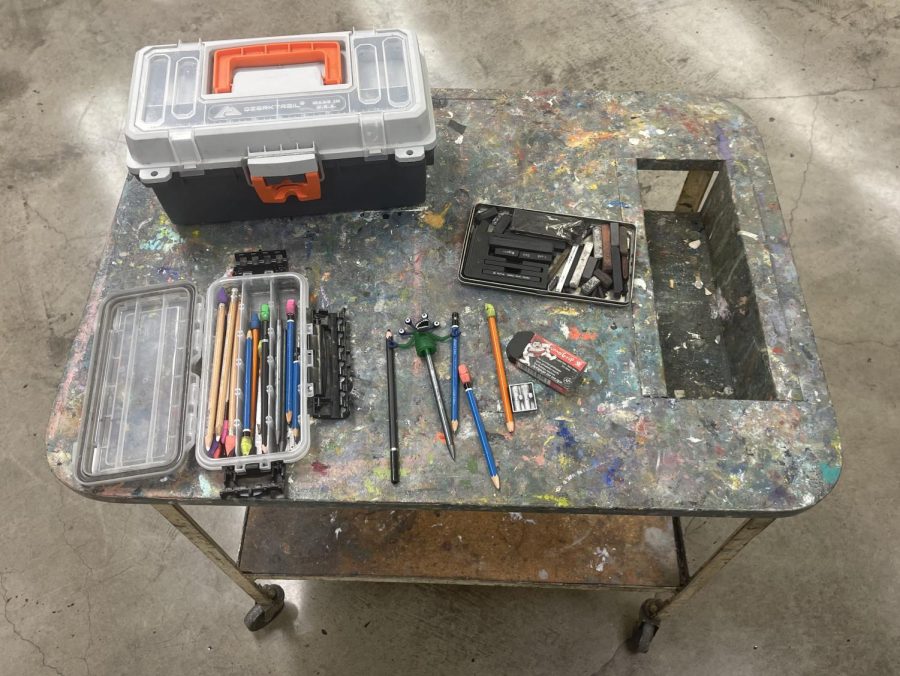
All ages, shapes, shades and sizes
Models provide art students with the most essential resource needed to both understand people and learn how to draw them – access to the human body in all its forms.
But, discrimination against people of color, women, transgender and LGBT2IQ2 people, elders, heavier people and people with disabilities eliminates opportunities for many models.
“Some art schools want greater diversity,” Garner says. “Not just what’s stereotypically pretty or glamourized.”
But she adds that this is not the norm.
At El Camino, models range in age from their 20s to 70s. They represent a wide variety of heights, weights and genders. In the past two semesters, at least four Black models and eight white models have worked on campus, although Asian, Indigenous and Latinx models haven’t been represented.
Garner believes that diversity of models is essential for the production of art, as well as the representation of life. She has experienced discrimination directly when that value isn’t prioritized.
“Women get judged, ignored and made invisible,” Garner says. “I’m not airbrushed. You can’t change the channel.”
She says she is what a real woman looks like.
“We are soft and we are hard,” she says.
Garner has developed a thick skin.
“We don’t work out, or if we do, we don’t work out in ways you think. I could be your mom, your aunt, your neighbor,” Garner says. “I’m 66. They’re not going to call me if they want a young woman, but my look is flexible. I can fix my hair and put on makeup or I can look like ten miles of bad road if they ask me to.”
She admits that there are always discussions about different body types. Schools have said they want “pretty, young girls, perky, not saggy.”
She knows they aren’t going to call her.
“I don’t find it disrespectful,” she says. “It comes with the territory.”
Hearing that she was interpreted in one student drawing as a tired mom struggling after a hard day of work to complete a long list of household chores, Garner laughs.
“That is what I want to be – a single mom sitting on top of the dryer – as much as I want to be Bathsheba (lover of King David and mother of King Solomon),” Garner says. “My attitude is what keeps me working.”
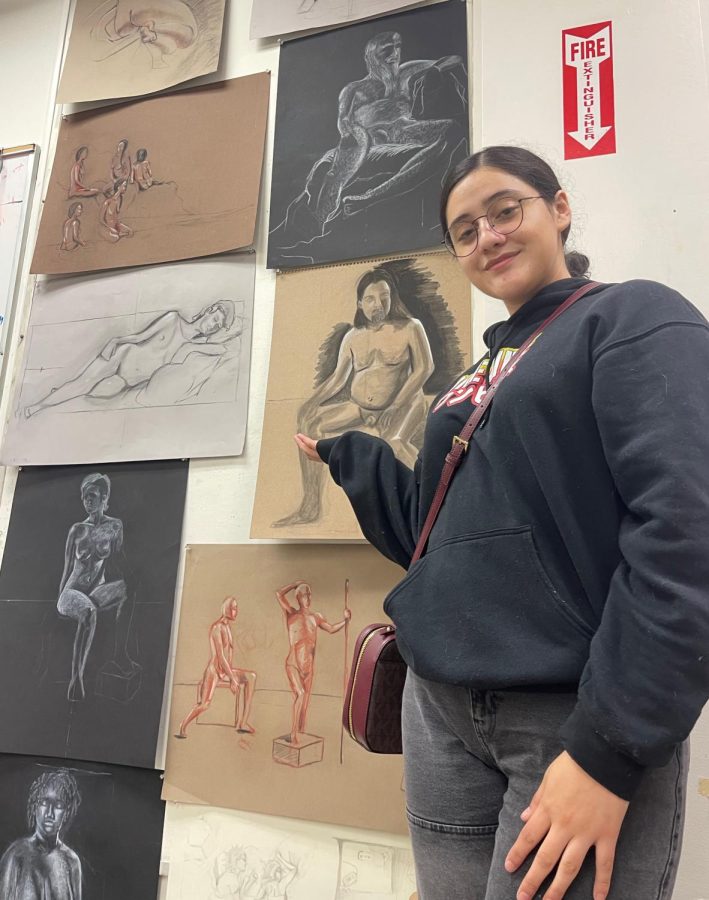
Artists, inventors and entrepreneurs
Jonathan Beck first worked as a model in 1979. He met his wife at the ArtCenter College of Design in Pasadena where they were both modeling. She had worked as a dancer in Hollywood and even worked with Gene Kelly. She was in TV shows also, like “Hawaii 5-0.” She left show business.
“Too many Harvey Weinsteins,” says Jonathan Beck. “It’s a very cut-throat, terrible place, a lot of back-stabbing competition.”
After getting married and having kids, Jonathan Beck left modeling to earn more money. He worked for Baskin Robbins at their training center.
“I taught franchise owners how to scoop ice cream,” he said.
In 2003, Jonathan Beck was laid off, so he went back to modeling and has been doing it ever since.
“I like freedom,” he says. “In modeling, you can be your own boss, leave a bad situation, just get off the [modeling] stand and walk out.”
Caraballo started modeling to help with bills and pay her way through school, but she says over time that changed.
“I began to find modeling to be creatively fulfilling for me. It got me back into art and art history, and being surrounded by other creatives working on their craft encourages me to keep working on my own,” she says.
She lives in South Los Angeles where she listens to a lot of music, enjoys cooking, is an avid gamer and has a book blog on Medium where she talks about her writing.
“Since high school, I also found a love for street photography, and I dabble in that here and there,” Caraballo says.
Cole began as a student at M.C. Williams Community School, Theatre and Dance Center in Houston where he studied ballet, modern and jazz dance. As a teenager, he performed with the Houston Ballet School and Company. In 1974, he studied theater arts at Carnegie-Mellon University in Pittsburg before moving to New York City where he performed on and off-Broadway, as well as with Nat Horne, Finis Jhung, Frank Hatchett, Martha Graham Dance Company and Alvin Ailey American Dance Theater.
“My life’s philosophy is simple, direct and to the point,” Cole says. “I do what I do when I do it, then it is done. I don’t have to show off, but just do my work impeccably well for the benefit of everybody involved.”
Cahner has a business degree, started a company and sold a company, but enjoys modeling.
“There’s something spiritually satisfying about it,” he says.
Garner started working as a live model when she was an art history and life drawing student at California State University, Fullerton in 1979. She earned a master’s degree in visual anthropology from CSUF and taught English and sociology in Inner Mongolia. She lived in the Middle East and has worked as a professional dancer in Middle Eastern, belly and Iranian folk dancing. She has a United Nations Educational, Scientific and Cultural Organization (UNESCO) certification in Kalbelia and other folk dance traditions from Rajasthan, India.
In 1992, she met her husband, Arthur Kusuhara, now 85, at the Long Beach Renaissance Fair. She is now Kusuhara’s full-time caregiver since he had a stroke and began losing his eyesight.
As a model, Garner incorporates her love for culture and life experience into her work, specializing in historic costuming. She recently helped to create a pirate pose at Saddleback College.
“I really love my job, and will go a long way to accommodate people – except shave my head. I won’t shave my head,” she says.
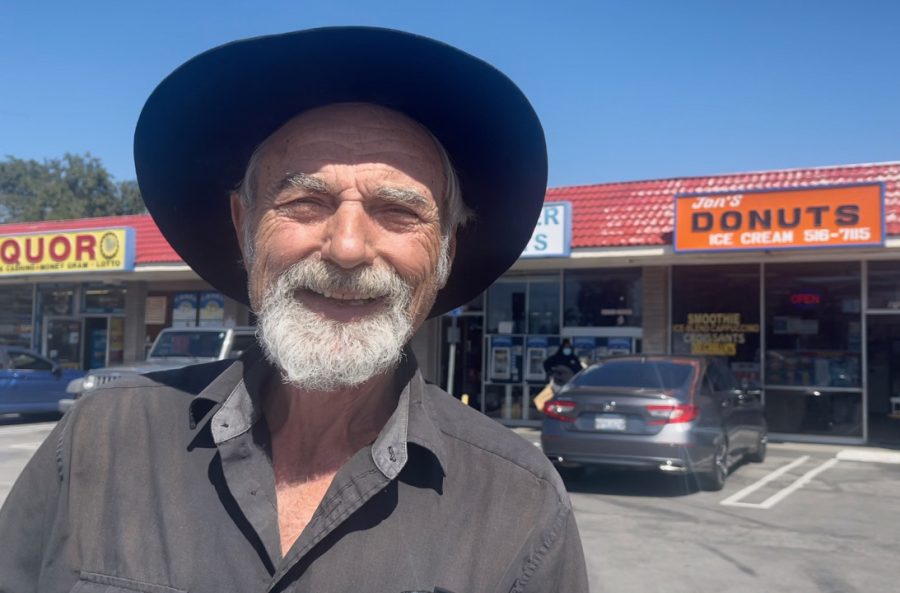
Tim Beck has made a dramatic career change every decade.
He grew up in Torrance and went to North High School. He says that despite getting a D in typing, he majored in journalism at El Camino College.
In the 1960s, he earned a bachelor’s degree in botany and a master’s degree in biology at UCLA, and was recruited to work as an organ transplant technician, because he was “big enough to push an 815-pound machine up a ramp.”
By the ’70s, he was assisting in surgeries to remove kidneys and prepare them for transport.
“You don’t need a medical license to operate on dead people,” he says.
He hitchhiked across the country with a sheepdog named Lord Randall, including looking for his brother at the commune in Canada. But the day before he arrived, Jonathan Beck had left for the east coast to see the sunrise with a girl named Laughing Water.
“Those were the days when LSD was called vitamin L,” he says, chuckling.
In the ’80s and ’90s, he taught science and math in public and private schools, but never lasted long due to his controversial teaching methods, including sharing tips with high school students about safer drug use.
In the early 2000s, Tim Beck moved back to his childhood home in Torrance to care for his ill mother. He began working as a model and also advocated that part of Sacred Cove Beach in Rancho Palos Verdes be an unofficial nude beach. They regularly ran from the police and argued with local residents who, according to him, “act like the beaches are their private front yards rather than belonging to all people.”
Five years ago, Tim Beck had throat cancer and received so much radiation and chemo that he was known to friends and hospital staff as “fall-out boy.” He dropped down to 120 pounds and spoke in art class about trying to get his “modeling muscles” back.
He has patents for several inventions including an improvement on the design of the Frisbee, the use of dry ice pellets and liquid nitrogen to put out an industrial fire, and an oil spill solution.
Reflecting on it all, Tim Beck sees art modeling as a highlight.
“Being an art model is a reward for achievements in good works,” he says. “Maybe the model in great paintings was nameless, maybe they got no money, but when a new portrait dropped it was carried through the streets, and people would come out of their shops to marvel at the artist’s work. And who is that guy? He is the art model.”
Then, he drops a large white envelope on the table with a detailed sketch that a student has drawn of his face.
“Who’s that guy? He’s an art model,” he says laughing.
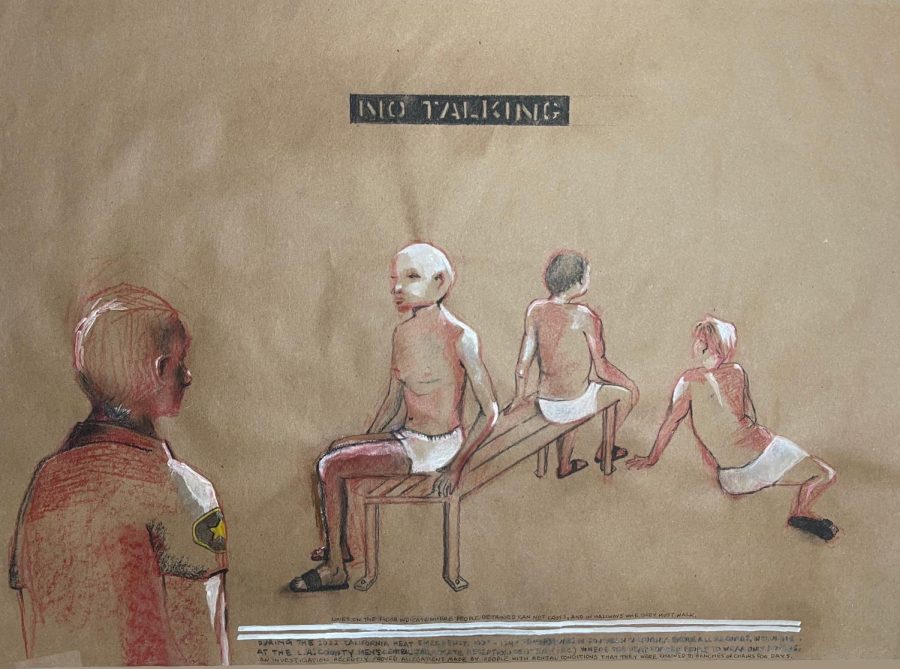
Editor’s Notes:
- Photos were added and enlarged on Thursday, June 15.
- Link was added on Sunday, Feb. 18.


